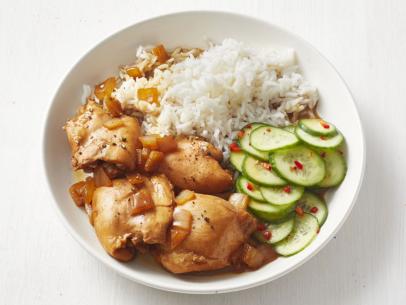
Recipe courtesy of
Andy Liang
for
Food Network Kitchen
Recipe courtesy of
Andy Liang
for
Food Network Kitchen
Watch how to make this recipe.
Tang Jai Jook
Getting reviews...
- Level: Intermediate
- Total: 9 hr 15 min (includes soaking time)
- Active: 1 hr
- Yield: 4 servings
-
- Nutritional Analysis
- Per Serving
- Serving Size
- 1 of 4 servings
- Calories
- 1144
- Total Fat
- 89 g
- Saturated Fat
- 12 g
- Carbohydrates
- 54 g
- Dietary Fiber
- 4 g
- Sugar
- 6 g
- Protein
- 34 g
- Cholesterol
- 184 mg
- Sodium
- 672 mg
This version of congee (rice porridge) known as tang jai jook translates as “little boat porridge,” a reference to its origin as a dish Cantonese fishermen would sell incorporating some of their day’s catch. Congee (jook in Cantonese) is a popular breakfast in many parts of Asia and can be served relatively plainly, or can incorporate varied toppings and mix-ins like seafood, salted pork and sometimes century egg. This is a recipe for a Cantonese-style pork-and-seafood congee featuring strips of salted pork, squid and fish cakes. It’s similar to what many restaurants in China, Hong Kong and elsewhere offer; you might see it listed as “sampan congee” on English menus, sampan being a small wooden boat. A garnish of fried red-skin peanuts is typical of tang jai jook and many other jooks; we highly recommend you make them since they add a deep nutty, salty flavor to this soul-warming porridge and can be made up to 5 days ahead. (Don’t make them too far in advance since they’re a tempting snack!) We also recommend serving this dish with youtiao, a typical accompaniment for breakfast sometimes called Chinese doughnuts or Chinese crullers. You can find frozen youtiao at some Asian food markets.
- Level: Intermediate
- Total: 9 hr 15 min (includes soaking time)
- Active: 1 hr
- Yield: 4 servings
-
- Nutritional Analysis
- Per Serving
- Serving Size
- 1 of 4 servings
- Calories
- 1144
- Total Fat
- 89 g
- Saturated Fat
- 12 g
- Carbohydrates
- 54 g
- Dietary Fiber
- 4 g
- Sugar
- 6 g
- Protein
- 34 g
- Cholesterol
- 184 mg
- Sodium
- 672 mg
Ingredients
Directions
- Place the rice in a medium bowl and wash it and drain it twice. Add enough cold water to the bowl to cover it by 1 inch; cover the bowl and refrigerate at least 8 hours and up to 12 hours.
- Place the pork, shaoxing wine and 1 teaspoon salt in a medium bowl and massage the ingredients into the pork until the salt dissolves. Cover and refrigerate at least 8 hours and up to 12 hours.
- Place the peanuts and 1 cup neutral oil in a medium saucepan over medium-low heat. Cook, swirling occasionally, until the peanuts are golden brown and the skin is deep brown, 12 to 15 minutes. Strain, saving the oil for another use. Lay the peanuts out on a paper towel–lined plate. Discard the oil. Sprinkle the peanuts with the fine sea salt and cool completely. As they cool, they will get crisper. Store in an airtight container at room temperature for up to 5 days.
- Pour 12 cups cold water into a 7-quart Dutch oven. Cover and bring to a boil over high heat.
- Pour off all the water from the soaked rice. Add 1/2 teaspoon kosher salt and remaining 1/2 teaspoon neutral oil and stir with a spatula or spoon until the oil and salt are well distributed and most of the rice grains are coated.
- Add the rice to the boiling water. Bring back up to a rolling boil, stirring continuously, about 4 minutes. Reduce the heat to medium-low and simmer, stirring every 10 to 15 minutes with a wooden spatula, until the mixture has thickened, the rice grains have broken down and the texture is similar to cooked grits, 30 to 40 minutes. (If it is too thick, you can thin it by adding warm water 1/2 cup at a time. To thicken it, simmer until it reaches the desired thickness, about 5 minutes.)
- Stir the pork into the rice and bring it back to a gentle boil. Cook, stirring occasionally, until the pork is tender, about 10 minutes.
- Meanwhile, cut the squid tubes lengthwise to open them up like a book and slice them into 1/2-inch-thick strips crosswise. Cut each squid tentacle cluster into 3 pieces lengthwise and set all aside in a small bowl.
- Add the squid, fish cake, bouillon powder and sugar to the rice. Cook until the squid turns white and opaque, about 3 minutes. Taste and add more salt if needed.
- Divide the congee among 4 bowls and garnish each with scallions, ginger and a handful of the roasted peanuts. Sprinkle with white pepper and serve the congee hot with youtiao on the side if desired.

































